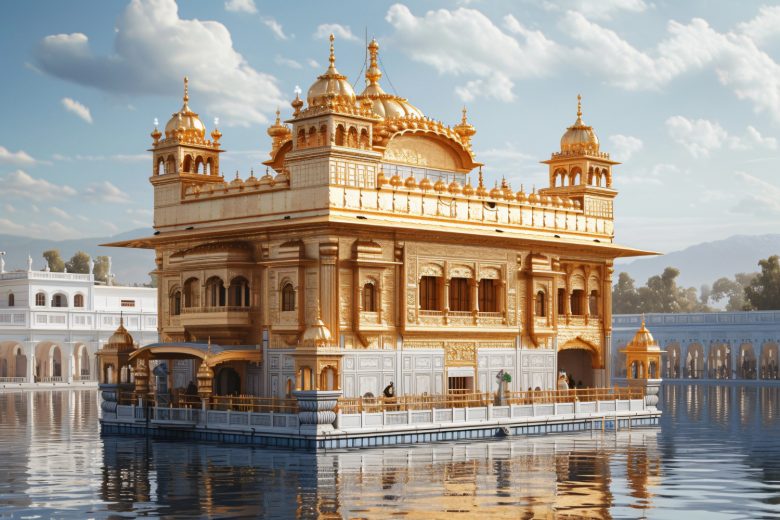Introduction
The Golden Temple, or Sri Harmandir Sahib, in Amritsar, India, stands as a testament to spirituality, humanism, and architectural brilliance. This sacred shrine attracts millions of visitors annually, offering a unique blend of cultural, religious, and historical experiences.
1. Spiritual Significance
Historical Importance
The Golden Temple holds immense historical significance as the spiritual and cultural nucleus of Sikhism. Built in the 16th century by Guru Arjan Dev Ji, it serves as the holiest shrine in Sikhism.
Cultural Relevance
Beyond its religious significance, the Golden Temple symbolizes unity, equality, and communal harmony—a beacon of hope and inspiration for people of all faiths.
2. Architectural Marvel

Photo by Darshak Pandya: https://www.pexels.com/photo/palace-near-body-of-water-574313/
Golden Structure
Adorned with over 750 kilograms of pure gold, the resplendent golden dome of the temple captivates visitors with its divine aura and grandeur.
Intricate Design
The temple’s architectural brilliance is further enhanced by its intricate marble inlay work, stunning domes, and ornate embellishments, reflecting the rich heritage of Sikh architecture.
3. Cultural Experience

Photo by Nav Photography: https://www.pexels.com/photo/golden-temple-near-water-in-evening-5458388/
Langar Tradition
Experience the essence of Sikh hospitality at the langar, a free community kitchen serving delicious meals to all visitors, irrespective of caste, creed, or religion.
Community Service
Participate in seva (selfless service) alongside volunteers, contributing to the preparation and serving of meals to thousands of devotees every day.
4. Historical Significance
Events and Incidents
The Golden Temple has borne witness to several historic events, including the Operation Blue Star in 1984—a tragic chapter in India’s history that left an indelible mark on Sikhism.
Jallianwala Bagh Memorial
Adjacent to the Golden Temple stands the Jallianwala Bagh Memorial, commemorating the victims of the Jallianwala Bagh massacre of 1919—a poignant reminder of India’s struggle for freedom.
5. Spiritual Atmosphere
Religious Practices
Engage in spiritual practices such as reciting hymns, offering prayers, and taking a dip in the sacred Amrit Sarovar (Pool of Nectar), believed to possess healing properties.
Tranquility and Peace
Amidst the bustling city of Amritsar, the Golden Temple offers a serene sanctuary where visitors can find solace, introspection, and inner peace.
6. Festive Celebrations
Diwali and Baisakhi Festivals
Experience the vibrant celebrations of Diwali and Baisakhi, when the temple is adorned with thousands of lights and flowers, creating a mesmerizing spectacle of color and joy.
Vibrant Atmosphere
During festivals, the temple resonates with the sounds of devotional music, hymns, and prayers, creating an atmosphere of spiritual fervor and celebration.
7. Symbol of Humanity
Equality and Inclusivity
The Golden Temple upholds the values of equality and inclusivity, where all are welcome to partake in the langar and seek blessings irrespective of social status or background.
Community Outreach Programs
The temple actively engages in various community outreach programs, including education, healthcare, and disaster relief, embodying the spirit of humanitarianism.
8. Architectural Brilliance
Reflective Pool
The temple’s tranquil sarovar, surrounded by marble walkways, offers stunning reflections of the golden structure, creating a mesmerizing visual spectacle.
Gilded Temple Structure
Marvel at the intricate details of the gilded temple structure, which reflects the skill and craftsmanship of Sikh artisans and craftsmen.
9. Cultural Harmony
Interfaith Harmony
The Golden Temple serves as a symbol of interfaith harmony, welcoming visitors of all faiths to partake in its rituals and experience its spiritual ambiance.
Global Visitors
Attracting visitors from around the globe, the temple fosters cultural exchange and understanding, promoting peace and harmony among diverse communities.
10. Tourist Attractions
Nearby Places of Interest
Explore the rich cultural heritage of Amritsar by visiting nearby attractions such as the historic Ram Bagh Palace, Wagah Border, and the serene Durgiana Temple.
Cultural Exchange Opportunities
Engage in cultural exchange opportunities with locals and fellow travelers, learning about Punjab’s rich traditions, cuisine, cultural practices, and folklore, enriching your travel experience and fostering meaningful connections.
Conclusion
A visit to the Golden Temple in Amritsar is not merely a sightseeing excursion but a profound journey of the soul. It offers a glimpse into the rich tapestry of Sikh culture, spirituality, and heritage. From its awe-inspiring architecture to its inclusive ethos, the Golden Temple leaves an indelible impression on all who visit, inspiring reverence, reflection, and renewal.
FAQs (Frequently Asked Questions)
Q: Is there an entry fee to visit the Golden Temple?
A: No, admission to the Golden Temple is free for all visitors.
Q: What are the best times to visit the Golden Temple to avoid crowds?
A: Early mornings and late evenings are ideal for a serene experience with fewer crowds.
Q: Are there any restrictions on photography inside the Golden Temple complex?
A: While photography is allowed in most areas, visitors are requested to refrain from taking pictures inside the sanctum sanctorum out of respect for Sikh traditions.
Q: How long does it take to explore the Golden Temple and its surroundings?
A: A leisurely visit to the Golden Temple complex and nearby attractions typically takes around 3-4 hours, allowing time for exploration and contemplation.
Q: Are there any specific dress code requirements for visiting the Golden Temple?
A: Visitors are required to cover their heads with scarves or turbans and remove their shoes before entering the main complex as a sign of respect.




